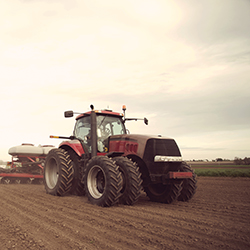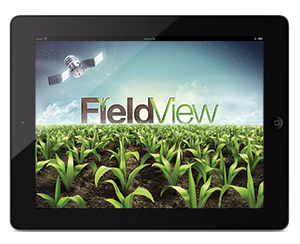
Based in Tremont, Precision Planting was founded in 1993 by Gregg and Cindy Sauder, who had a talent for developing planter add-ons to achieve precise depth and spacing to maximize crop performance on their own farm. Since then, the company has grown to become a technology leader, developing software, hardware and production equipment to help farmers improve yield and productivity. In 2012, Precision Planting was acquired by Monsanto Co. for $210 million, plus a performance-based payment of up to $40 million. It is now part of Monsanto’s Integrated Farming Systems unit, which utilizes advanced agronomic practices, seed genetics and technology to improve yield. iBi caught up with Sean Arians, the firm’s marketing manager, to learn more.
How did Precision Planting get its start? What is its mission?
The details have always been important to Gregg and Cindy Sauder, founders of Precision Planting. By paying attention to the details, they learned that precision placement paid huge dividends on their corn and soybean operation near Tremont. Gregg experimented on ways to get precise depth control and tinkered with seed meters trying to eliminate the skips (missing plants) and doubles (extra plants) that occurred in his cornfields.
Naturally, his neighbors kept an eye on this aggressive young farm couple. When others saw his improved stands, he started tinkering with meters for friends and neighbors. Then Eugene Keeton, inventor of the finger pickup corn meter and the brush meter for soybeans, came to Gregg and Cindy with his newest invention, the Seed Firmer. After testing and trial, the Sauders became the exclusive distributor of this revolutionary planter attachment. That was the beginning of Precision Planting in 1993.
Precision Planting is the headquarters for new ideas and technology that contribute to better seed spacing, better depth control and better root systems. The scope of the company has changed to include proprietary meter components, the MeterMax meter calibration system, and a broad range of Keeton Seed Firmers. We have also introduced new planter electronic systems that give you new ways to manage planters by understanding singulation (how accurate a meter segregates seed from the seed pool for planting), impact of speed, down force and more.
In 2012, we launched another industry-leading solution for farmers called FieldView. This app is available on iTunes for farmers to take their iPad in the cab or wherever they go, so data management becomes easier than ever before. We have expanded the app to include wireless data transfer and management, enabling farmers to see their whole operation on an iPad or the FieldView website.

Describe the company’s network of dealers and distributors.
Precision Planting has a broad dealer network across the U.S., Canada, Argentina, Brazil, Ukraine, South Africa, New Zealand and Australia. We have more than 800 independent dealers who represent Precision Planting, ranging from ag retail locations to farmers who wanted to help their neighbors improve their farming operations.
How does the depth and spacing of seeds impact crop growth? How does precise placement translate into improved yield?
Uneven depth changes the distance for the seedling to exit the ground and reach sunlight. As a plant gets to the surface and beats its neighbor out of the ground, it can cause competition for nutrients in the soil. If a more mature plant gets to the nutrients first, it causes them to be unavailable for the other plants and reduces yield. Precise placement is similar: two plants being too close together creates competition for vital nutrients in the soil. If they are both competing in a small area, they aren’t able to maximize their yield potential.
What are some current trends in planting technologies?
Technology is the buzz with all operations of the farm. We excel at helping farmers achieve more with the planter they currently own. With our product line, a farmer is able to put new technology on an older planter and make it as efficient as—or better than—a new planter. Technology allows farmers to do more with less, manage their operations in a whole new way, and ultimately make decisions faster than ever before.
Describe the purchase of Precision by Monsanto in 2012. How did that deal come about?
Monsanto acquired Precision Planting to become the first part of Integrated Farming Systems. With technology in the cab and the ability to maximize planter performance, we were a natural step in helping them execute their FieldScripts platform, a highly-granular variable rate prescription for a yield management zone. Accurate execution and technology to wirelessly transfer those prescriptions were key factors in partnering with Precision Planting to be the in-cab system of choice.
How has Precision evolved since this purchase? Are the Sauders still actively involved in the business?
Gregg and his son Tim remained involved up until five months ago. Gregg’s desire to help farmers achieve more continues as Precision Planting expands its Tremont-based operations, and now a facility in Morton. We continue to grow market share across the world and gain new partnerships with Monsanto to assist in developing the best technology in the industry.
Describe the joint venture to build Precision Acre, the world’s premier decision agriculture platform. What is the vision for this product?
Precision Acre is the initial program of integrated software and hardware. The vision is to provide tools to help farmers with decisions faster than ever before. As the season progresses, farmers will have data at their fingertips, enhanced with real-time data from the field. The goal is to provide seamless data in a simple way that uses up-to-the-minute weather and field data.
What do you believe is the biggest misconception about farming?
Misinformed consumers. With over 317 million people in the United States, only two percent claim farming as an occupation. This leaves a large number of people without a connection to agriculture. While the industry employs 21 million people, there are many that still do not understand where their food comes from.
The agriculture industry has become a victim of its own success. The American farmer has always worked hard to provide for his family, going about his daily chores and caring for his crops and livestock. Instead of engaging the consumer, he continually worked hard to produce the products of his toil. Today, we cannot sit idly by as consumers and anti-agriculture organizations work as hard to oppose the farmer. Farmers must engage with consumers and help them understand. They must be transparent about how they produce raw products, educate them on their processes, and help them realize the truth about where their food comes from. The Farm Bureau has done a lot of work to promote these efforts through an alliance with the U.S. Farmers & Ranchers Alliance, which has enabled farmers to get in front of many different people. This is a great start, but only a start.
The consumer often oversimplifies and takes for granted the abundance of food in America without understanding everything that is required for them to eat breakfast, lunch and supper. Together, farmers and the Farm Bureau can continue to promote this message and share the truth about American agriculture. iBi

